Ethical Analysis of Mobile Threats in Enterprise Applications
VerifiedAdded on 2022/11/18
|6
|2194
|130
Essay
AI Summary
This essay, submitted by a Charles Sturt University student, analyzes the ethical implications of mobile threats targeting enterprise applications. The essay explores the threats through the lens of four classical ethical theories: utilitarianism, deontology, contract theory, and virtue ethics. It examines how these theories apply to scenarios such as data theft and the impersonation of enterprise applications, arguing that the threats are unethical due to their lack of utility, violation of moral obligations, and disregard for social contracts and moral duties. The essay includes an introduction, detailed analysis of each ethical theory, and a conclusion that justifies the recommendations made throughout the analysis. The student used the article "5 Active Mobile Threats Spoofing Enterprise Apps" as the basis for the essay, conducting further research to support the arguments. The essay concludes that the mobile threats are unethical and that ethical issues related to data security should be addressed promptly.
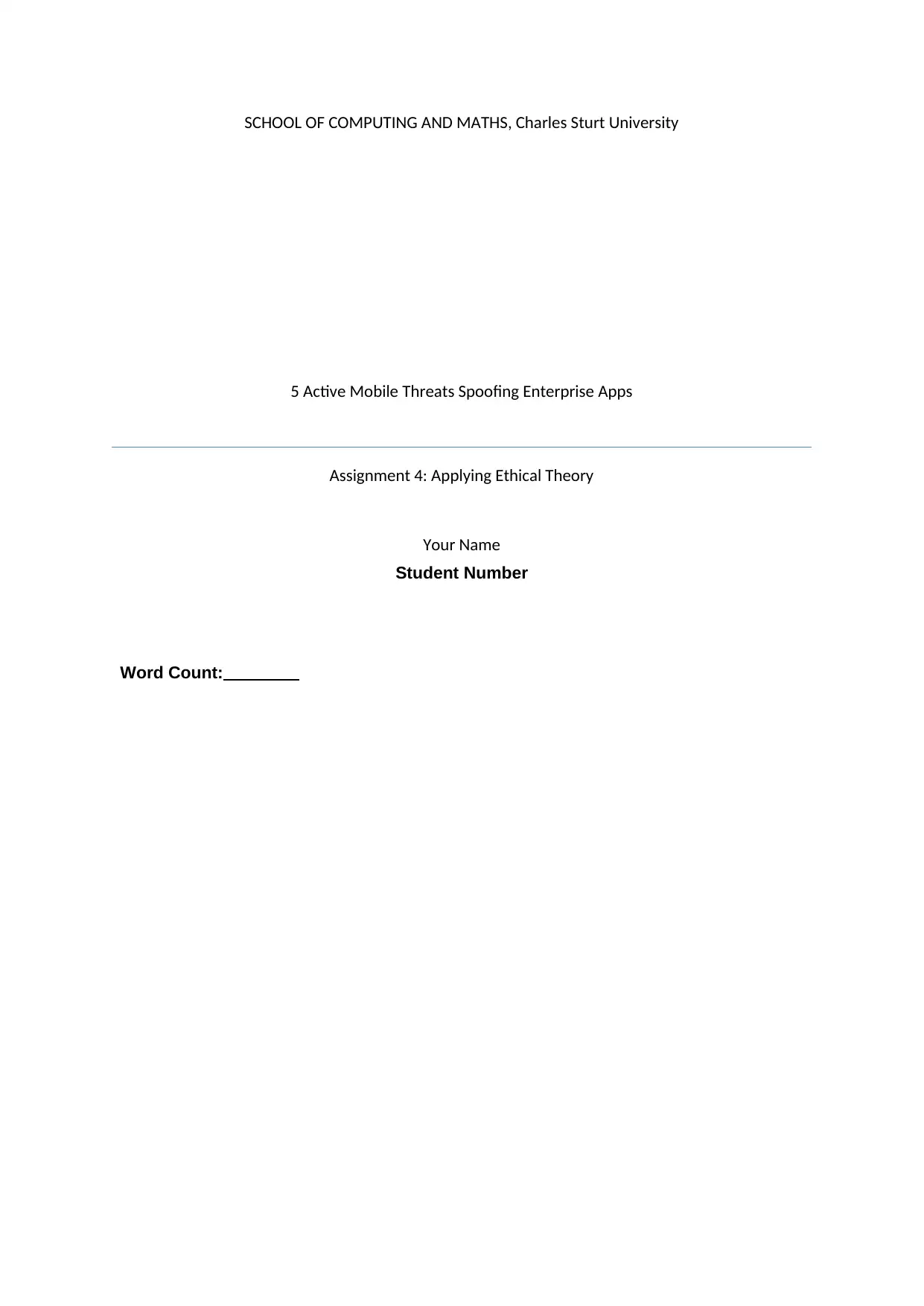
SCHOOL OF COMPUTING AND MATHS, Charles Sturt University
5 Active Mobile Threats Spoofing Enterprise Apps
Assignment 4: Applying Ethical Theory
Your Name
Student Number
Word Count:
5 Active Mobile Threats Spoofing Enterprise Apps
Assignment 4: Applying Ethical Theory
Your Name
Student Number
Word Count:
Paraphrase This Document
Need a fresh take? Get an instant paraphrase of this document with our AI Paraphraser
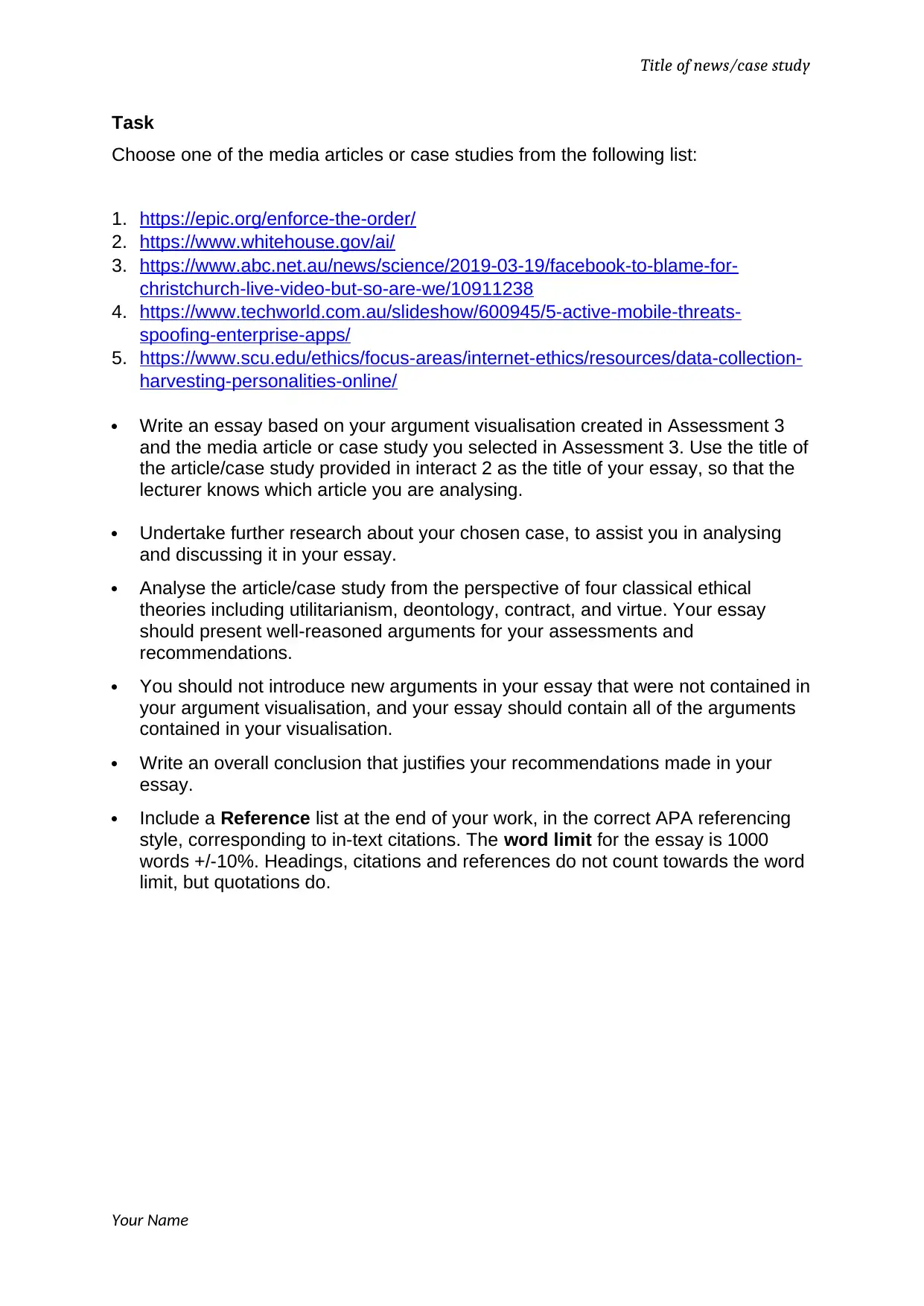
Title of news/case study
Task
Choose one of the media articles or case studies from the following list:
1. https://epic.org/enforce-the-order/
2. https://www.whitehouse.gov/ai/
3. https://www.abc.net.au/news/science/2019-03-19/facebook-to-blame-for-
christchurch-live-video-but-so-are-we/10911238
4. https://www.techworld.com.au/slideshow/600945/5-active-mobile-threats-
spoofing-enterprise-apps/
5. https://www.scu.edu/ethics/focus-areas/internet-ethics/resources/data-collection-
harvesting-personalities-online/
Write an essay based on your argument visualisation created in Assessment 3
and the media article or case study you selected in Assessment 3. Use the title of
the article/case study provided in interact 2 as the title of your essay, so that the
lecturer knows which article you are analysing.
Undertake further research about your chosen case, to assist you in analysing
and discussing it in your essay.
Analyse the article/case study from the perspective of four classical ethical
theories including utilitarianism, deontology, contract, and virtue. Your essay
should present well-reasoned arguments for your assessments and
recommendations.
You should not introduce new arguments in your essay that were not contained in
your argument visualisation, and your essay should contain all of the arguments
contained in your visualisation.
Write an overall conclusion that justifies your recommendations made in your
essay.
Include a Reference list at the end of your work, in the correct APA referencing
style, corresponding to in-text citations. The word limit for the essay is 1000
words +/-10%. Headings, citations and references do not count towards the word
limit, but quotations do.
Your Name
Task
Choose one of the media articles or case studies from the following list:
1. https://epic.org/enforce-the-order/
2. https://www.whitehouse.gov/ai/
3. https://www.abc.net.au/news/science/2019-03-19/facebook-to-blame-for-
christchurch-live-video-but-so-are-we/10911238
4. https://www.techworld.com.au/slideshow/600945/5-active-mobile-threats-
spoofing-enterprise-apps/
5. https://www.scu.edu/ethics/focus-areas/internet-ethics/resources/data-collection-
harvesting-personalities-online/
Write an essay based on your argument visualisation created in Assessment 3
and the media article or case study you selected in Assessment 3. Use the title of
the article/case study provided in interact 2 as the title of your essay, so that the
lecturer knows which article you are analysing.
Undertake further research about your chosen case, to assist you in analysing
and discussing it in your essay.
Analyse the article/case study from the perspective of four classical ethical
theories including utilitarianism, deontology, contract, and virtue. Your essay
should present well-reasoned arguments for your assessments and
recommendations.
You should not introduce new arguments in your essay that were not contained in
your argument visualisation, and your essay should contain all of the arguments
contained in your visualisation.
Write an overall conclusion that justifies your recommendations made in your
essay.
Include a Reference list at the end of your work, in the correct APA referencing
style, corresponding to in-text citations. The word limit for the essay is 1000
words +/-10%. Headings, citations and references do not count towards the word
limit, but quotations do.
Your Name
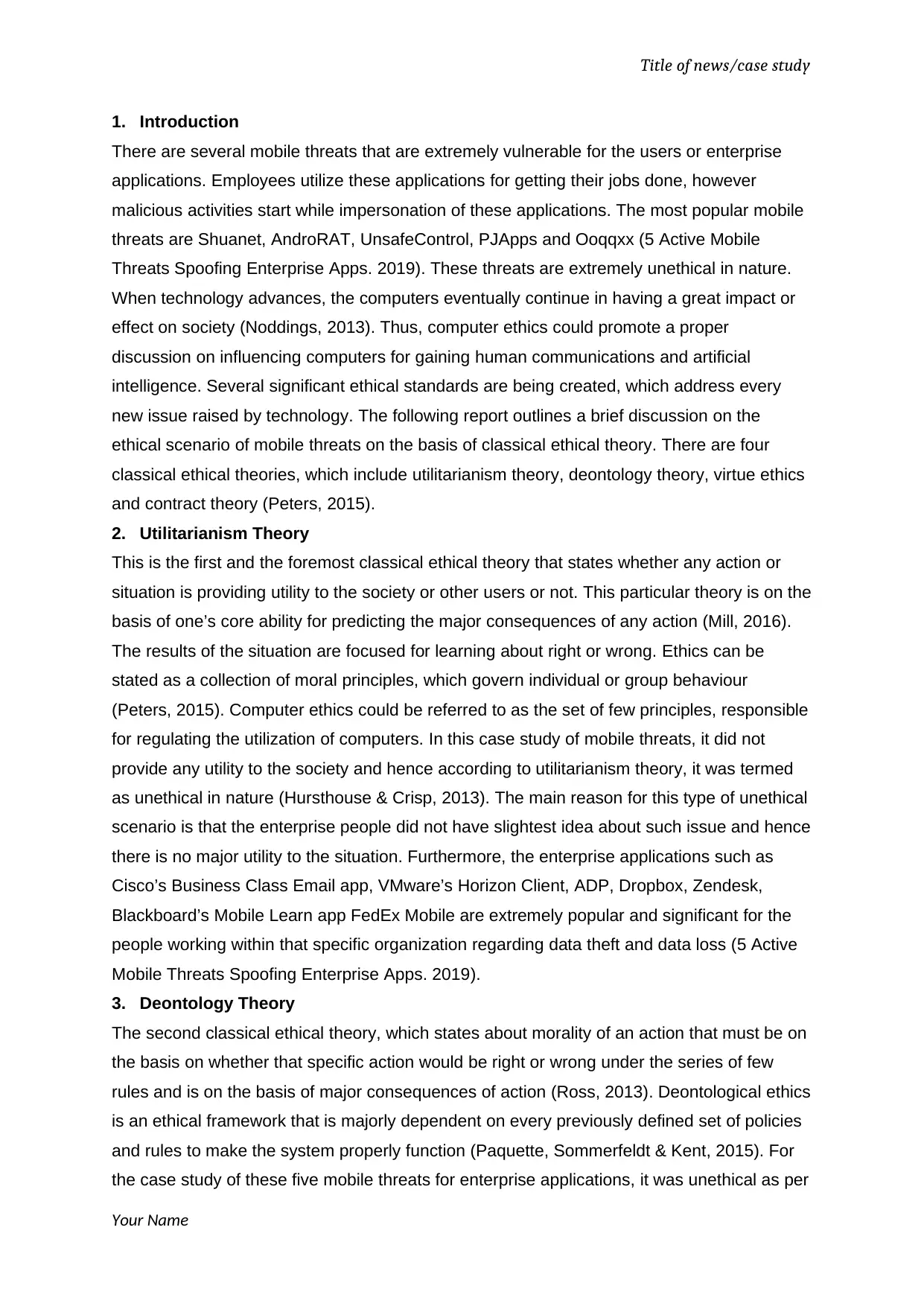
Title of news/case study
1. Introduction
There are several mobile threats that are extremely vulnerable for the users or enterprise
applications. Employees utilize these applications for getting their jobs done, however
malicious activities start while impersonation of these applications. The most popular mobile
threats are Shuanet, AndroRAT, UnsafeControl, PJApps and Ooqqxx (5 Active Mobile
Threats Spoofing Enterprise Apps. 2019). These threats are extremely unethical in nature.
When technology advances, the computers eventually continue in having a great impact or
effect on society (Noddings, 2013). Thus, computer ethics could promote a proper
discussion on influencing computers for gaining human communications and artificial
intelligence. Several significant ethical standards are being created, which address every
new issue raised by technology. The following report outlines a brief discussion on the
ethical scenario of mobile threats on the basis of classical ethical theory. There are four
classical ethical theories, which include utilitarianism theory, deontology theory, virtue ethics
and contract theory (Peters, 2015).
2. Utilitarianism Theory
This is the first and the foremost classical ethical theory that states whether any action or
situation is providing utility to the society or other users or not. This particular theory is on the
basis of one’s core ability for predicting the major consequences of any action (Mill, 2016).
The results of the situation are focused for learning about right or wrong. Ethics can be
stated as a collection of moral principles, which govern individual or group behaviour
(Peters, 2015). Computer ethics could be referred to as the set of few principles, responsible
for regulating the utilization of computers. In this case study of mobile threats, it did not
provide any utility to the society and hence according to utilitarianism theory, it was termed
as unethical in nature (Hursthouse & Crisp, 2013). The main reason for this type of unethical
scenario is that the enterprise people did not have slightest idea about such issue and hence
there is no major utility to the situation. Furthermore, the enterprise applications such as
Cisco’s Business Class Email app, VMware’s Horizon Client, ADP, Dropbox, Zendesk,
Blackboard’s Mobile Learn app FedEx Mobile are extremely popular and significant for the
people working within that specific organization regarding data theft and data loss (5 Active
Mobile Threats Spoofing Enterprise Apps. 2019).
3. Deontology Theory
The second classical ethical theory, which states about morality of an action that must be on
the basis on whether that specific action would be right or wrong under the series of few
rules and is on the basis of major consequences of action (Ross, 2013). Deontological ethics
is an ethical framework that is majorly dependent on every previously defined set of policies
and rules to make the system properly function (Paquette, Sommerfeldt & Kent, 2015). For
the case study of these five mobile threats for enterprise applications, it was unethical as per
Your Name
1. Introduction
There are several mobile threats that are extremely vulnerable for the users or enterprise
applications. Employees utilize these applications for getting their jobs done, however
malicious activities start while impersonation of these applications. The most popular mobile
threats are Shuanet, AndroRAT, UnsafeControl, PJApps and Ooqqxx (5 Active Mobile
Threats Spoofing Enterprise Apps. 2019). These threats are extremely unethical in nature.
When technology advances, the computers eventually continue in having a great impact or
effect on society (Noddings, 2013). Thus, computer ethics could promote a proper
discussion on influencing computers for gaining human communications and artificial
intelligence. Several significant ethical standards are being created, which address every
new issue raised by technology. The following report outlines a brief discussion on the
ethical scenario of mobile threats on the basis of classical ethical theory. There are four
classical ethical theories, which include utilitarianism theory, deontology theory, virtue ethics
and contract theory (Peters, 2015).
2. Utilitarianism Theory
This is the first and the foremost classical ethical theory that states whether any action or
situation is providing utility to the society or other users or not. This particular theory is on the
basis of one’s core ability for predicting the major consequences of any action (Mill, 2016).
The results of the situation are focused for learning about right or wrong. Ethics can be
stated as a collection of moral principles, which govern individual or group behaviour
(Peters, 2015). Computer ethics could be referred to as the set of few principles, responsible
for regulating the utilization of computers. In this case study of mobile threats, it did not
provide any utility to the society and hence according to utilitarianism theory, it was termed
as unethical in nature (Hursthouse & Crisp, 2013). The main reason for this type of unethical
scenario is that the enterprise people did not have slightest idea about such issue and hence
there is no major utility to the situation. Furthermore, the enterprise applications such as
Cisco’s Business Class Email app, VMware’s Horizon Client, ADP, Dropbox, Zendesk,
Blackboard’s Mobile Learn app FedEx Mobile are extremely popular and significant for the
people working within that specific organization regarding data theft and data loss (5 Active
Mobile Threats Spoofing Enterprise Apps. 2019).
3. Deontology Theory
The second classical ethical theory, which states about morality of an action that must be on
the basis on whether that specific action would be right or wrong under the series of few
rules and is on the basis of major consequences of action (Ross, 2013). Deontological ethics
is an ethical framework that is majorly dependent on every previously defined set of policies
and rules to make the system properly function (Paquette, Sommerfeldt & Kent, 2015). For
the case study of these five mobile threats for enterprise applications, it was unethical as per
Your Name
⊘ This is a preview!⊘
Do you want full access?
Subscribe today to unlock all pages.

Trusted by 1+ million students worldwide
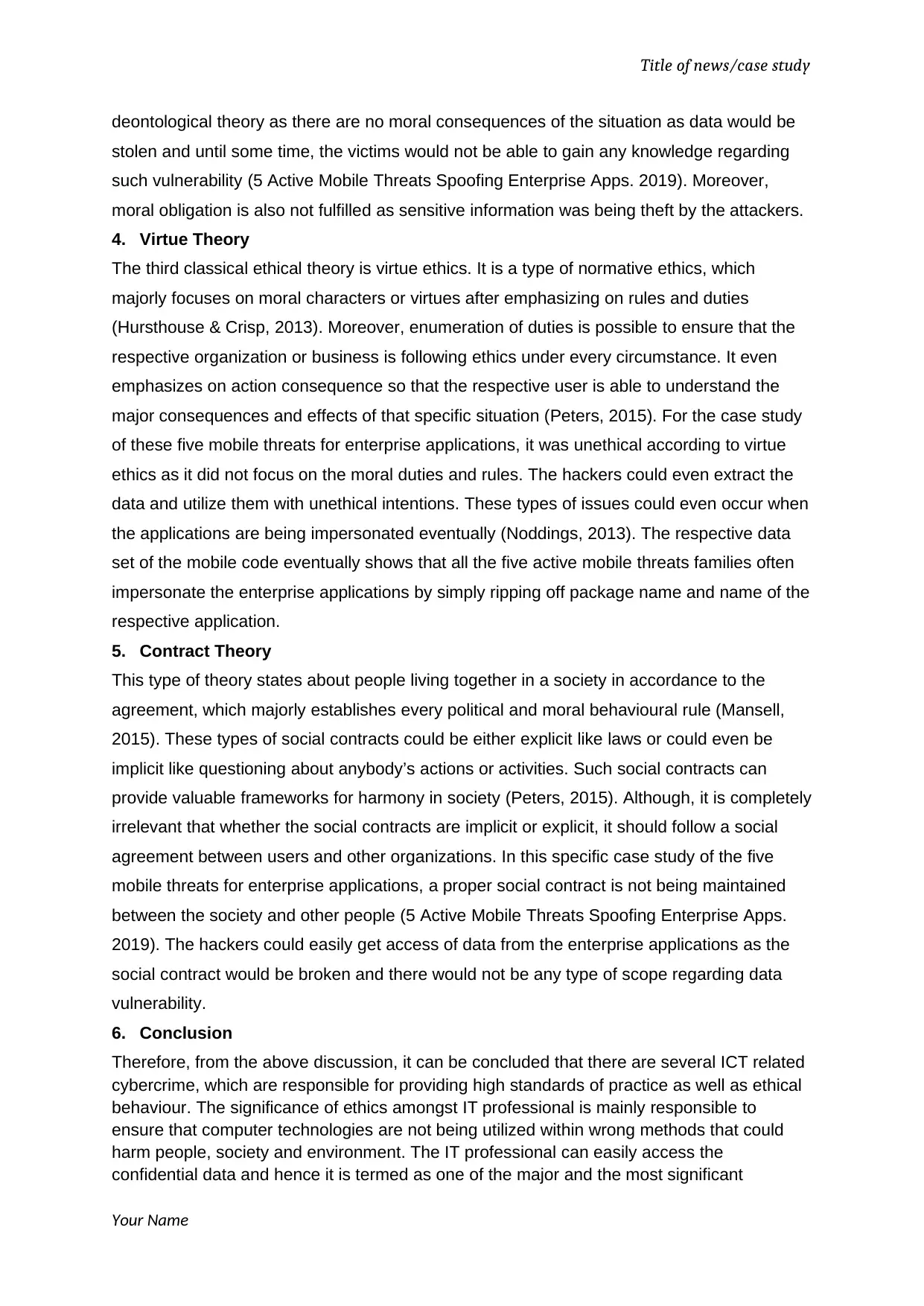
Title of news/case study
deontological theory as there are no moral consequences of the situation as data would be
stolen and until some time, the victims would not be able to gain any knowledge regarding
such vulnerability (5 Active Mobile Threats Spoofing Enterprise Apps. 2019). Moreover,
moral obligation is also not fulfilled as sensitive information was being theft by the attackers.
4. Virtue Theory
The third classical ethical theory is virtue ethics. It is a type of normative ethics, which
majorly focuses on moral characters or virtues after emphasizing on rules and duties
(Hursthouse & Crisp, 2013). Moreover, enumeration of duties is possible to ensure that the
respective organization or business is following ethics under every circumstance. It even
emphasizes on action consequence so that the respective user is able to understand the
major consequences and effects of that specific situation (Peters, 2015). For the case study
of these five mobile threats for enterprise applications, it was unethical according to virtue
ethics as it did not focus on the moral duties and rules. The hackers could even extract the
data and utilize them with unethical intentions. These types of issues could even occur when
the applications are being impersonated eventually (Noddings, 2013). The respective data
set of the mobile code eventually shows that all the five active mobile threats families often
impersonate the enterprise applications by simply ripping off package name and name of the
respective application.
5. Contract Theory
This type of theory states about people living together in a society in accordance to the
agreement, which majorly establishes every political and moral behavioural rule (Mansell,
2015). These types of social contracts could be either explicit like laws or could even be
implicit like questioning about anybody’s actions or activities. Such social contracts can
provide valuable frameworks for harmony in society (Peters, 2015). Although, it is completely
irrelevant that whether the social contracts are implicit or explicit, it should follow a social
agreement between users and other organizations. In this specific case study of the five
mobile threats for enterprise applications, a proper social contract is not being maintained
between the society and other people (5 Active Mobile Threats Spoofing Enterprise Apps.
2019). The hackers could easily get access of data from the enterprise applications as the
social contract would be broken and there would not be any type of scope regarding data
vulnerability.
6. Conclusion
Therefore, from the above discussion, it can be concluded that there are several ICT related
cybercrime, which are responsible for providing high standards of practice as well as ethical
behaviour. The significance of ethics amongst IT professional is mainly responsible to
ensure that computer technologies are not being utilized within wrong methods that could
harm people, society and environment. The IT professional can easily access the
confidential data and hence it is termed as one of the major and the most significant
Your Name
deontological theory as there are no moral consequences of the situation as data would be
stolen and until some time, the victims would not be able to gain any knowledge regarding
such vulnerability (5 Active Mobile Threats Spoofing Enterprise Apps. 2019). Moreover,
moral obligation is also not fulfilled as sensitive information was being theft by the attackers.
4. Virtue Theory
The third classical ethical theory is virtue ethics. It is a type of normative ethics, which
majorly focuses on moral characters or virtues after emphasizing on rules and duties
(Hursthouse & Crisp, 2013). Moreover, enumeration of duties is possible to ensure that the
respective organization or business is following ethics under every circumstance. It even
emphasizes on action consequence so that the respective user is able to understand the
major consequences and effects of that specific situation (Peters, 2015). For the case study
of these five mobile threats for enterprise applications, it was unethical according to virtue
ethics as it did not focus on the moral duties and rules. The hackers could even extract the
data and utilize them with unethical intentions. These types of issues could even occur when
the applications are being impersonated eventually (Noddings, 2013). The respective data
set of the mobile code eventually shows that all the five active mobile threats families often
impersonate the enterprise applications by simply ripping off package name and name of the
respective application.
5. Contract Theory
This type of theory states about people living together in a society in accordance to the
agreement, which majorly establishes every political and moral behavioural rule (Mansell,
2015). These types of social contracts could be either explicit like laws or could even be
implicit like questioning about anybody’s actions or activities. Such social contracts can
provide valuable frameworks for harmony in society (Peters, 2015). Although, it is completely
irrelevant that whether the social contracts are implicit or explicit, it should follow a social
agreement between users and other organizations. In this specific case study of the five
mobile threats for enterprise applications, a proper social contract is not being maintained
between the society and other people (5 Active Mobile Threats Spoofing Enterprise Apps.
2019). The hackers could easily get access of data from the enterprise applications as the
social contract would be broken and there would not be any type of scope regarding data
vulnerability.
6. Conclusion
Therefore, from the above discussion, it can be concluded that there are several ICT related
cybercrime, which are responsible for providing high standards of practice as well as ethical
behaviour. The significance of ethics amongst IT professional is mainly responsible to
ensure that computer technologies are not being utilized within wrong methods that could
harm people, society and environment. The IT professional can easily access the
confidential data and hence it is termed as one of the major and the most significant
Your Name
Paraphrase This Document
Need a fresh take? Get an instant paraphrase of this document with our AI Paraphraser
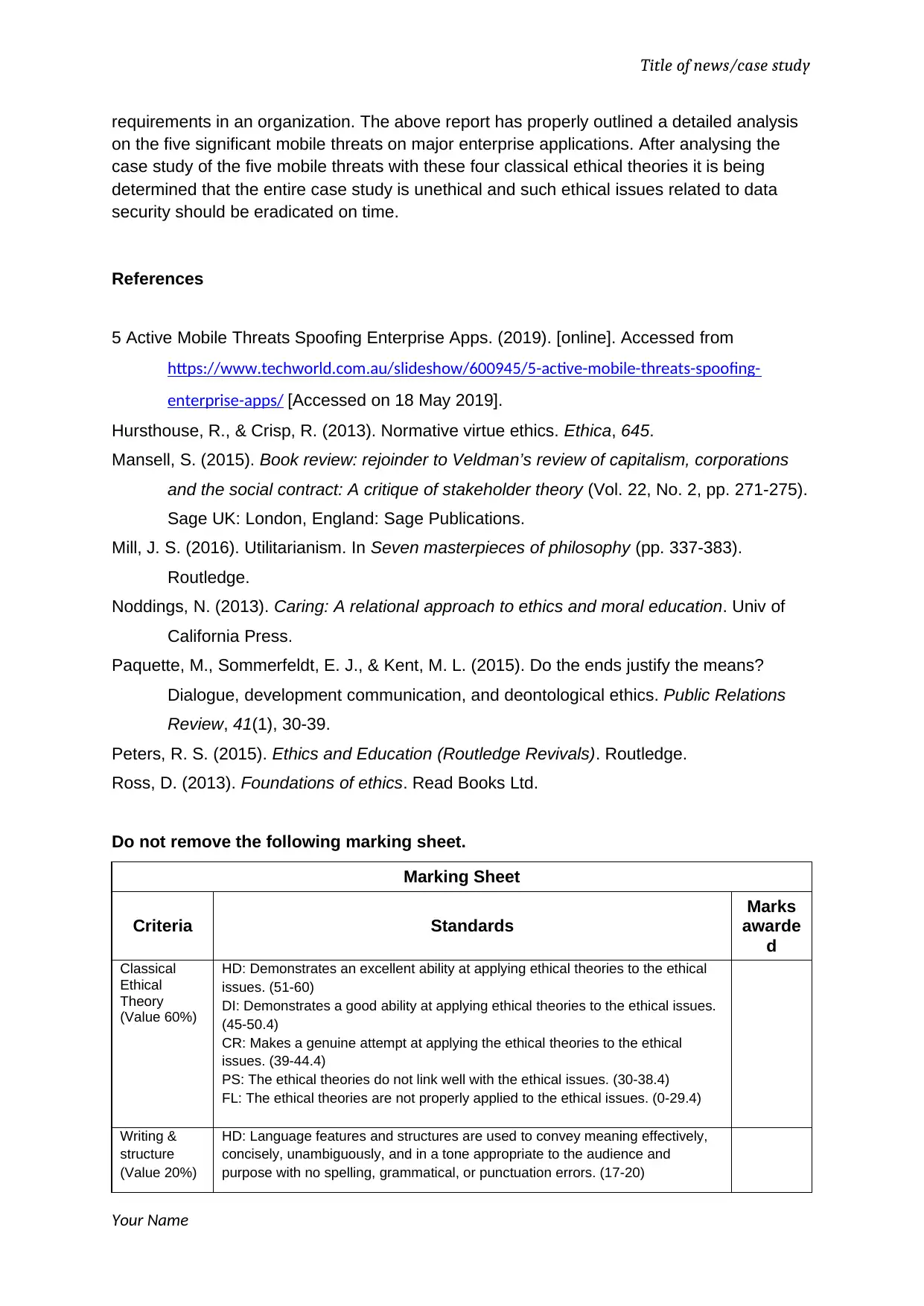
Title of news/case study
requirements in an organization. The above report has properly outlined a detailed analysis
on the five significant mobile threats on major enterprise applications. After analysing the
case study of the five mobile threats with these four classical ethical theories it is being
determined that the entire case study is unethical and such ethical issues related to data
security should be eradicated on time.
References
5 Active Mobile Threats Spoofing Enterprise Apps. (2019). [online]. Accessed from
https://www.techworld.com.au/slideshow/600945/5-active-mobile-threats-spoofing-
enterprise-apps/ [Accessed on 18 May 2019].
Hursthouse, R., & Crisp, R. (2013). Normative virtue ethics. Ethica, 645.
Mansell, S. (2015). Book review: rejoinder to Veldman’s review of capitalism, corporations
and the social contract: A critique of stakeholder theory (Vol. 22, No. 2, pp. 271-275).
Sage UK: London, England: Sage Publications.
Mill, J. S. (2016). Utilitarianism. In Seven masterpieces of philosophy (pp. 337-383).
Routledge.
Noddings, N. (2013). Caring: A relational approach to ethics and moral education. Univ of
California Press.
Paquette, M., Sommerfeldt, E. J., & Kent, M. L. (2015). Do the ends justify the means?
Dialogue, development communication, and deontological ethics. Public Relations
Review, 41(1), 30-39.
Peters, R. S. (2015). Ethics and Education (Routledge Revivals). Routledge.
Ross, D. (2013). Foundations of ethics. Read Books Ltd.
Do not remove the following marking sheet.
Marking Sheet
Criteria Standards
Marks
awarde
d
Classical
Ethical
Theory
(Value 60%)
HD: Demonstrates an excellent ability at applying ethical theories to the ethical
issues. (51-60)
DI: Demonstrates a good ability at applying ethical theories to the ethical issues.
(45-50.4)
CR: Makes a genuine attempt at applying the ethical theories to the ethical
issues. (39-44.4)
PS: The ethical theories do not link well with the ethical issues. (30-38.4)
FL: The ethical theories are not properly applied to the ethical issues. (0-29.4)
Writing &
structure
(Value 20%)
HD: Language features and structures are used to convey meaning effectively,
concisely, unambiguously, and in a tone appropriate to the audience and
purpose with no spelling, grammatical, or punctuation errors. (17-20)
Your Name
requirements in an organization. The above report has properly outlined a detailed analysis
on the five significant mobile threats on major enterprise applications. After analysing the
case study of the five mobile threats with these four classical ethical theories it is being
determined that the entire case study is unethical and such ethical issues related to data
security should be eradicated on time.
References
5 Active Mobile Threats Spoofing Enterprise Apps. (2019). [online]. Accessed from
https://www.techworld.com.au/slideshow/600945/5-active-mobile-threats-spoofing-
enterprise-apps/ [Accessed on 18 May 2019].
Hursthouse, R., & Crisp, R. (2013). Normative virtue ethics. Ethica, 645.
Mansell, S. (2015). Book review: rejoinder to Veldman’s review of capitalism, corporations
and the social contract: A critique of stakeholder theory (Vol. 22, No. 2, pp. 271-275).
Sage UK: London, England: Sage Publications.
Mill, J. S. (2016). Utilitarianism. In Seven masterpieces of philosophy (pp. 337-383).
Routledge.
Noddings, N. (2013). Caring: A relational approach to ethics and moral education. Univ of
California Press.
Paquette, M., Sommerfeldt, E. J., & Kent, M. L. (2015). Do the ends justify the means?
Dialogue, development communication, and deontological ethics. Public Relations
Review, 41(1), 30-39.
Peters, R. S. (2015). Ethics and Education (Routledge Revivals). Routledge.
Ross, D. (2013). Foundations of ethics. Read Books Ltd.
Do not remove the following marking sheet.
Marking Sheet
Criteria Standards
Marks
awarde
d
Classical
Ethical
Theory
(Value 60%)
HD: Demonstrates an excellent ability at applying ethical theories to the ethical
issues. (51-60)
DI: Demonstrates a good ability at applying ethical theories to the ethical issues.
(45-50.4)
CR: Makes a genuine attempt at applying the ethical theories to the ethical
issues. (39-44.4)
PS: The ethical theories do not link well with the ethical issues. (30-38.4)
FL: The ethical theories are not properly applied to the ethical issues. (0-29.4)
Writing &
structure
(Value 20%)
HD: Language features and structures are used to convey meaning effectively,
concisely, unambiguously, and in a tone appropriate to the audience and
purpose with no spelling, grammatical, or punctuation errors. (17-20)
Your Name
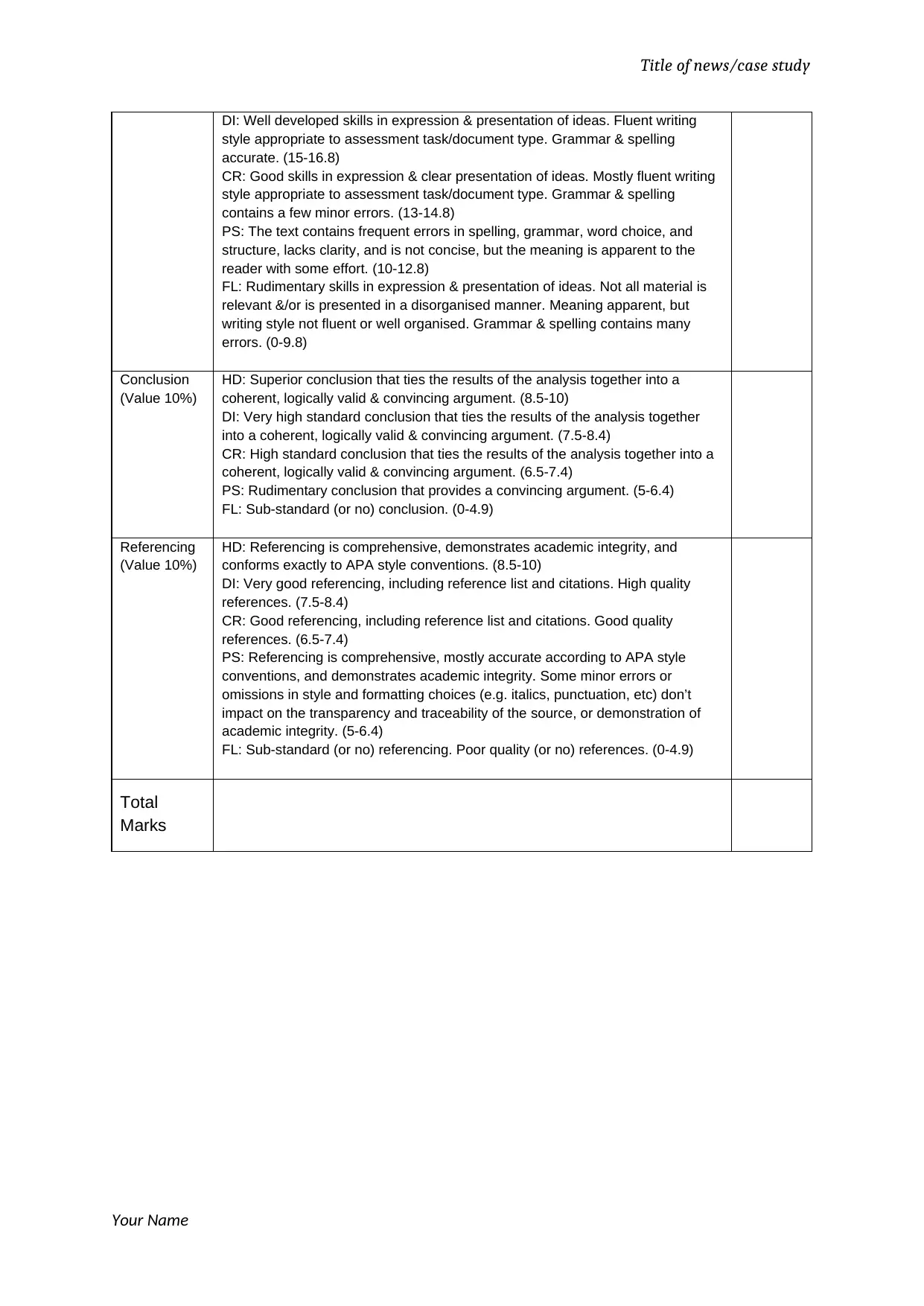
Title of news/case study
DI: Well developed skills in expression & presentation of ideas. Fluent writing
style appropriate to assessment task/document type. Grammar & spelling
accurate. (15-16.8)
CR: Good skills in expression & clear presentation of ideas. Mostly fluent writing
style appropriate to assessment task/document type. Grammar & spelling
contains a few minor errors. (13-14.8)
PS: The text contains frequent errors in spelling, grammar, word choice, and
structure, lacks clarity, and is not concise, but the meaning is apparent to the
reader with some effort. (10-12.8)
FL: Rudimentary skills in expression & presentation of ideas. Not all material is
relevant &/or is presented in a disorganised manner. Meaning apparent, but
writing style not fluent or well organised. Grammar & spelling contains many
errors. (0-9.8)
Conclusion
(Value 10%)
HD: Superior conclusion that ties the results of the analysis together into a
coherent, logically valid & convincing argument. (8.5-10)
DI: Very high standard conclusion that ties the results of the analysis together
into a coherent, logically valid & convincing argument. (7.5-8.4)
CR: High standard conclusion that ties the results of the analysis together into a
coherent, logically valid & convincing argument. (6.5-7.4)
PS: Rudimentary conclusion that provides a convincing argument. (5-6.4)
FL: Sub-standard (or no) conclusion. (0-4.9)
Referencing
(Value 10%)
HD: Referencing is comprehensive, demonstrates academic integrity, and
conforms exactly to APA style conventions. (8.5-10)
DI: Very good referencing, including reference list and citations. High quality
references. (7.5-8.4)
CR: Good referencing, including reference list and citations. Good quality
references. (6.5-7.4)
PS: Referencing is comprehensive, mostly accurate according to APA style
conventions, and demonstrates academic integrity. Some minor errors or
omissions in style and formatting choices (e.g. italics, punctuation, etc) don’t
impact on the transparency and traceability of the source, or demonstration of
academic integrity. (5-6.4)
FL: Sub-standard (or no) referencing. Poor quality (or no) references. (0-4.9)
Total
Marks
Your Name
DI: Well developed skills in expression & presentation of ideas. Fluent writing
style appropriate to assessment task/document type. Grammar & spelling
accurate. (15-16.8)
CR: Good skills in expression & clear presentation of ideas. Mostly fluent writing
style appropriate to assessment task/document type. Grammar & spelling
contains a few minor errors. (13-14.8)
PS: The text contains frequent errors in spelling, grammar, word choice, and
structure, lacks clarity, and is not concise, but the meaning is apparent to the
reader with some effort. (10-12.8)
FL: Rudimentary skills in expression & presentation of ideas. Not all material is
relevant &/or is presented in a disorganised manner. Meaning apparent, but
writing style not fluent or well organised. Grammar & spelling contains many
errors. (0-9.8)
Conclusion
(Value 10%)
HD: Superior conclusion that ties the results of the analysis together into a
coherent, logically valid & convincing argument. (8.5-10)
DI: Very high standard conclusion that ties the results of the analysis together
into a coherent, logically valid & convincing argument. (7.5-8.4)
CR: High standard conclusion that ties the results of the analysis together into a
coherent, logically valid & convincing argument. (6.5-7.4)
PS: Rudimentary conclusion that provides a convincing argument. (5-6.4)
FL: Sub-standard (or no) conclusion. (0-4.9)
Referencing
(Value 10%)
HD: Referencing is comprehensive, demonstrates academic integrity, and
conforms exactly to APA style conventions. (8.5-10)
DI: Very good referencing, including reference list and citations. High quality
references. (7.5-8.4)
CR: Good referencing, including reference list and citations. Good quality
references. (6.5-7.4)
PS: Referencing is comprehensive, mostly accurate according to APA style
conventions, and demonstrates academic integrity. Some minor errors or
omissions in style and formatting choices (e.g. italics, punctuation, etc) don’t
impact on the transparency and traceability of the source, or demonstration of
academic integrity. (5-6.4)
FL: Sub-standard (or no) referencing. Poor quality (or no) references. (0-4.9)
Total
Marks
Your Name
⊘ This is a preview!⊘
Do you want full access?
Subscribe today to unlock all pages.

Trusted by 1+ million students worldwide
1 out of 6
Related Documents
Your All-in-One AI-Powered Toolkit for Academic Success.
+13062052269
info@desklib.com
Available 24*7 on WhatsApp / Email
![[object Object]](/_next/static/media/star-bottom.7253800d.svg)
Unlock your academic potential
Copyright © 2020–2025 A2Z Services. All Rights Reserved. Developed and managed by ZUCOL.





